Jan 2000 – Feb 2001
Here are excerpts from the Minutes of the meetings of the Depleted Uranium Firing Environmental Review Committee which relate to the firings at at the Kirkcudbright Range, near Dundrennan, Dumfries and Galloway.
An introduction to these Minutes is here.
Acronyms:
KTA, Kirkcudbright Training Area, Ministry of Defence (MOD)
DERA, The Defence Evaluation and Research Agency, established in April 1991 as part of the MOD. In July 2001, DERA was split into two organisations:
QinetiQ, a privatised commercial company, and
DSTL, Defence Science and Technology Laboratory (MOD)
RO, Royal Ordnance
BNFL, British Nuclear Fuels Ltd.
EA, Environment Agency
SEPA, Scottish Environment Protection Agency
DTEO, Defence Test and Evaluation Organisation (MOD)
PLSD, Protection and Life Sciences Division (MOD)
CDA, Centre for Defence Analysis (MOD)
D SEF Pol, Directorate of Safety, Environmental and Fire Policy (MOD)
DG(Nuc), Director General (Nuclear) (MOD)
DUWG, Depleted Uranium Working Group (MOD)
Excerpts from Minutes of the 21st Meeting of the Depleted Uranium Firing Environmental Review Committee (DUFERC) on Thursday 27 January 2000
(update) According to DG(Nuc), the current custodian is accountable for nuclear material held outside the Armed service. It therefore seem probably that DERA is accountable for the various quantities of DU in varying states held at locations within DERA.
(Redacted name) commented that if DU used in manufacture of rounds was contaminated with small quantities of fission products with short half-lives, this may not particularly be a problem, but that gross contamination was. A rough ‘worst case’ estimate had been prepared and it had been concluded that, from the available information, the quantities of contaminants were so low as to be insignificant…It was suggested that summary be provided to customers, regulators, and other interested parties…
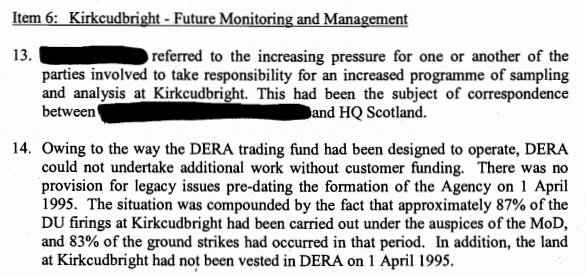
(Redacted name) reported that she had been encountering difficulties in finding a suitable method of removing the corrosion products from DU pellets without attacking the DU metal as well … trial and error tests were underway … Regarding the marine garden, Luce Bay was no longer a viable option; consideration was now being diverted back to Kirkcudbright…
Full text here.
Excerpts from Minutes of the 22nd Meeting of the Depleted Uranium Firing Environmental Review Committee (DUFERC) on Thursday 18 May 2000
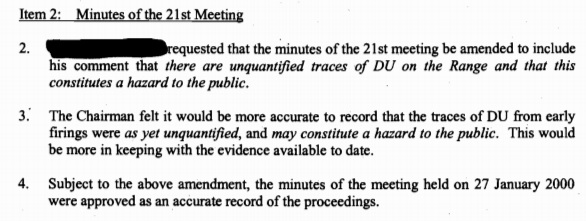
FY1999/2000 had seen expenditure of approximately £660k, by T&E Ranges, covering corrosion studies, environmental monitoring, surveys and the DUFERC. Support for these activities would have to continue from the Sector’s budget … Additionally, a series of activities had been proposed which would result in ‘one-off’ expenditure of approximately £900k in 2000-01. This would cover items such as land remediation, marine and terrestrial modelling, a seabed search, and PQ management. As no central funding was available from DERA and no source had been forthcoming from MoD, it would not be possible to proceed with this programme.
(discussion about Public Private Partnership arrangements for DERA) … (Redacted name) informed the DUFERC that he also sat on the MoD’s newly-formed Depleted Uranium Working Group and that he would also raise the issue of finance in that forum.
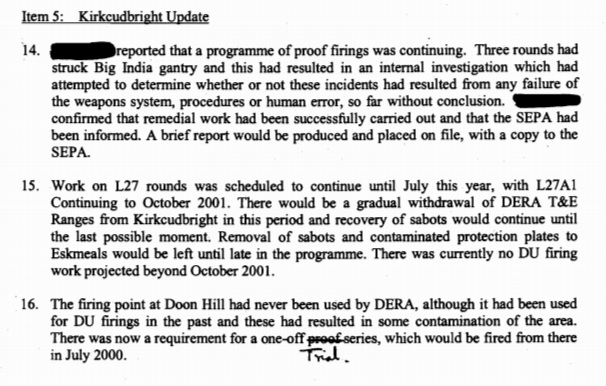

(Redacted name) was pleased to report that most of the barriers to establishing the marine garden at Kirkcudbright had been removed … It had not been decided how – or, indeed, whether – to mark the location of the garden. Possibly the simplest option would be to arrange for a Temporary Notice to Mariners to be issued with the details of the location.
(Redacted name) reported that he had attended a meeting with (Redacted name), a Kirkcudbright resident and anti-DU campaigner, with (Redacted name) and (Redacted name) of D&G Council’s Environmental Health Department. The meeting included a site visit to the River Dee where [redacted name] was able to point out the exact location of the alleged (radioactive) mooring blocks … none of the mooring blocks that had been found were radioactive .. the allegations had no basis in fact.
Full text here.
Excerpts from Minutes of the 23rd Meeting of the Depleted Uranium Firing Environmental Review Committee (DUFERC) on Thursday 17 August 2000
(Redacted name) was pleased to report that the trial at Doon Hill had completed successfully and with no incidents. However, monitoring had revealed discrete pieces of old DU contamination.
(Redacted name) presented a brief outline of the draft Kirkcudbright 1999 Terrestrial and draft Kirkcudbright 1998-99 Marine environmental survey reports.
It was confirmed that there are currently no DU firings at Kirkcudbright after October 2001 but that there may be some, very minor, work after that date.
(re: DU garden) Due to a lack of sediment cover at the chosen location, it had not been possible to conduct the ‘drop’ test with a DU projectile and it may also be necessary to move the whole garden for the same reason.
Full text here.
Excerpts from Minutes of the 24th Meeting of the Depleted Uranium Firing Environmental Review Committee (DUFERC) 21 November 2000
There are no Minutes for the 24th Meeting.
Excerpts from Minutes of the 25th Meeting of the Depleted Uranium Firing Environmental Review Committee (DUFERC) Tuesday 27 February 2001
The most recent of the planned firings at Kirkcudbright had taken place without incident during the week of 19 February. There were a further five serials, each of 10 or 12 rounds, remaining to complete the programme. The next was scheduled for 2 April, weather permitting.
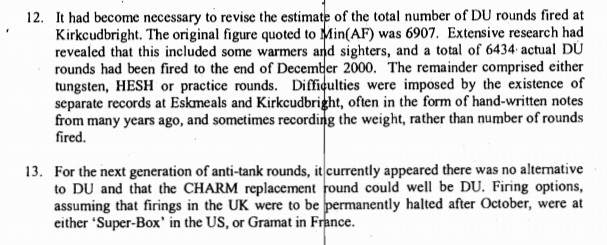

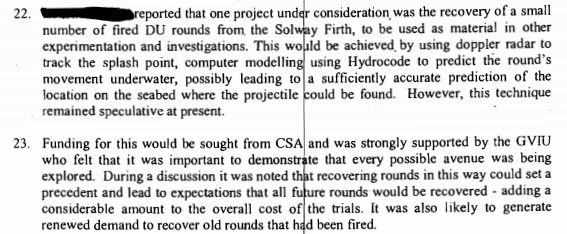
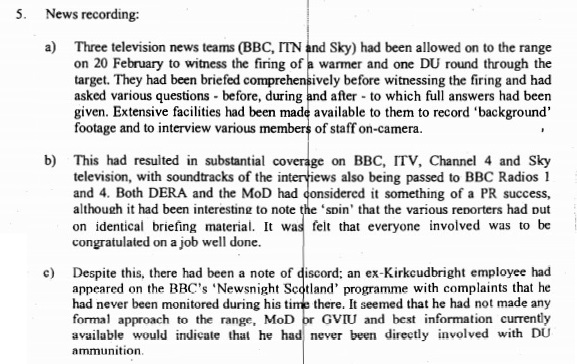
DU gardens update: (Redacted name) informed the Committee that the underwater frame holding the marine samples had been damaged badly, the most likely cause being repeated impact by the marker buoy chains during bad weather … (the rig) had been properly designed and solidly constructed and it was only the extreme conditions and an entirely unpredictable set of circumstances that had resulted in its demise.

Full text here.


